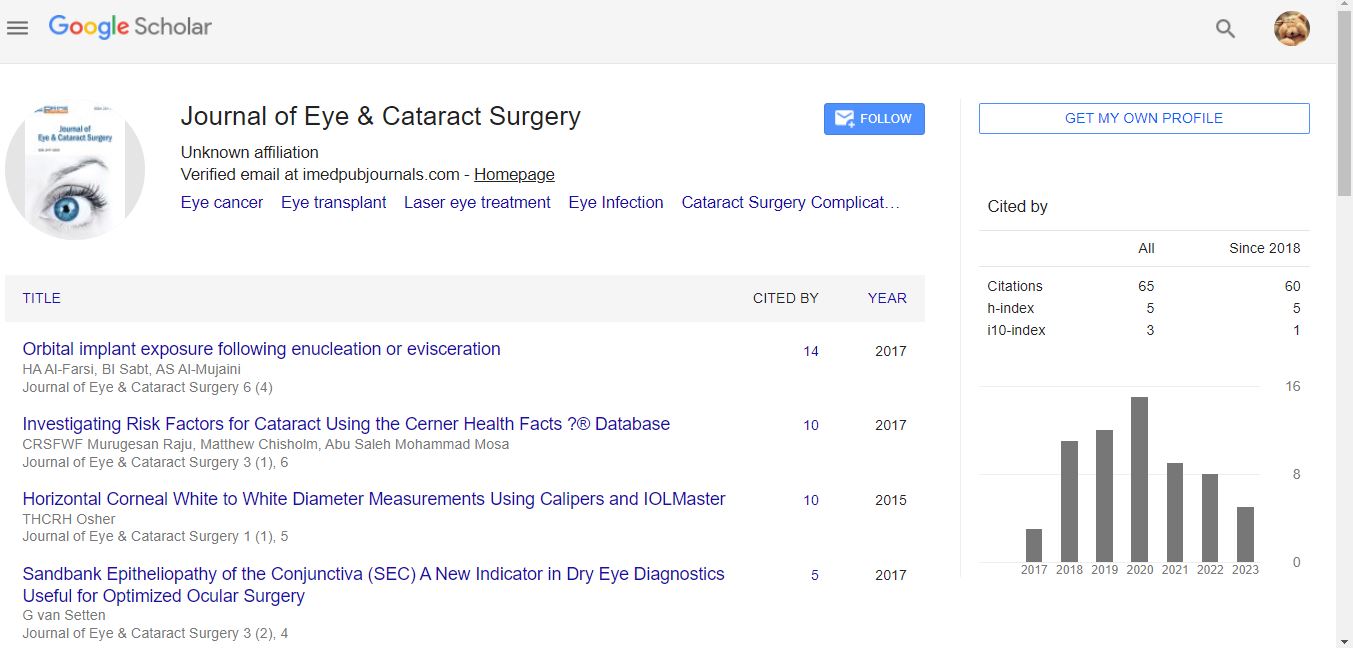Commentary - (2024) Volume 10, Issue 4
Advances in Eye Cancer Treatment: From Surgery to Immunotherapy
Eva Maria*
Department of Radiation Oncology, Aston University, UK
*Correspondence:
Eva Maria,
Department of Radiation Oncology, Aston University,
UK,
Email:
Received: 02-Dec-2024, Manuscript No. IPJECS-25-22557;
Editor assigned: 04-Dec-2024, Pre QC No. IPJECS-25-22557 (PQ);
Reviewed: 18-Dec-2024, QC No. IPJECS-25-22557;
Revised: 23-Dec-2024, Manuscript No. IPJECS-25-22557 (R);
Published:
30-Dec-2024, DOI: 10.36648/2471-8300.10.4.33
Description
Treatment of secondary eye cancer typically involves addressing the primary cancer, often through systemic therapies such as chemotherapy, immunotherapy, or targeted therapy. Radiation therapy may also be used to treat the eye tumor. The symptoms of eye cancer can vary depending on the type of cancer and its location in the eye. Many of the symptoms are similar to those of other eye conditions, so it is important to consult an ophthalmologist for an accurate diagnosis. Common symptoms of eye cancer include. Blurred vision, double vision, or sudden vision loss in one eye may occur due to the tumour's effect on the retina or optic nerve. While not always present, some individuals with eye cancer may experience pain or a sensation of fullness in the eye. Eye cancer may cause visible changes such as a protruding eyeball, an abnormal pupil shape, or an eye that appears red or swollen. These are often caused by the tumor interfering with the retina, leading to visual disturbances. In the case of retinoblastoma, a white reflection (known as "cat's eye reflex") may be visible in the pupil, which is often noticed in photographs. In some cases, the tumor can cause the eye to bulge outwards, a condition called proptosis. The exact cause of eye cancer is not always clear, but certain factors may increase the risk of developing eye cancer. Some of the known risk factors include. Inherited genetic mutations can increase the risk of certain types of eye cancer, such as retinoblastoma, which is linked to mutations in the RB1 gene. Certain types of eye cancer, such as uveal melanoma, are more common in older adults, typically those over the age of 50. A family history of eye cancer or certain genetic syndromes, such as Li-Fraumeni syndrome or neurofibromatosis, can increase the risk of developing eye cancer. Long-term exposure to ultraviolet radiation from the sun or tanning beds can increase the risk of uveal melanoma, particularly in individuals with fair skin and light-coloured eyes. Individuals who have had certain types of cancer, such as melanoma, may be at an increased risk of developing secondary eye cancer. Diagnosing eye cancer requires a thorough eye examination by an ophthalmologist, along with advanced imaging techniques to identify the presence of tumours. The diagnostic process typically includes. A detailed eye examination is the first step in diagnosing eye cancer. This includes checking visual acuity, eye movement, and the appearance of the eye and its components. During a fundus examination, the doctor uses a special lens to view the back of the eye and the retina, allowing them to identify any abnormal growths or tumours. An ocular ultrasound uses sound waves to create images of the inside of the eye, which can help detect tumours in the retina or the uvea. OCT is an imaging technique that provides highresolution images of the retina, helping doctors identify retinal tumours and other abnormalities. In some cases, a biopsy may be required to confirm the diagnosis of eye cancer. This involves removing a small sample of tissue from the tumor and analysing it in a laboratory.
Acknowledgement
None.
Conflict Of Interest
The author's declared that they have no conflict of interest.
Citation: Maria E (2024) Advances in Eye Cancer Treatment: From Surgery to Immunotherapy. J Eye Cataract Surg. 10:33.
Copyright: © 2024 Maria E. This is an open-access article distributed under the terms of the Creative Commons Attribution License, which permits unrestricted use, distribution, and reproduction in any medium, provided the original author and source are credited.

